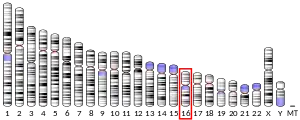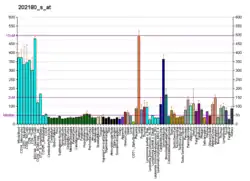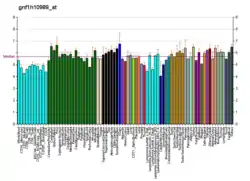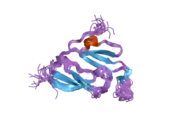Major vault protein
Major vault protein is a protein that in humans is encoded by the MVP gene.[5][6] 78 copies of the protein assemble into the large compartments called vaults.
| MVP | |||||||||||||||||||||||||||||||||||||||||||||||||||
|---|---|---|---|---|---|---|---|---|---|---|---|---|---|---|---|---|---|---|---|---|---|---|---|---|---|---|---|---|---|---|---|---|---|---|---|---|---|---|---|---|---|---|---|---|---|---|---|---|---|---|---|
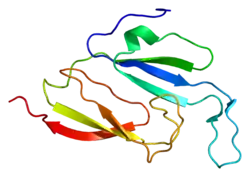 | |||||||||||||||||||||||||||||||||||||||||||||||||||
| |||||||||||||||||||||||||||||||||||||||||||||||||||
| Identifiers | |||||||||||||||||||||||||||||||||||||||||||||||||||
| Aliases | MVP, LRP, VAULT1, major vault protein | ||||||||||||||||||||||||||||||||||||||||||||||||||
| External IDs | OMIM: 605088 MGI: 1925638 HomoloGene: 3752 GeneCards: MVP | ||||||||||||||||||||||||||||||||||||||||||||||||||
| |||||||||||||||||||||||||||||||||||||||||||||||||||
| |||||||||||||||||||||||||||||||||||||||||||||||||||
| |||||||||||||||||||||||||||||||||||||||||||||||||||
| |||||||||||||||||||||||||||||||||||||||||||||||||||
| |||||||||||||||||||||||||||||||||||||||||||||||||||
| Wikidata | |||||||||||||||||||||||||||||||||||||||||||||||||||
| |||||||||||||||||||||||||||||||||||||||||||||||||||
Function
This gene encodes the major vault protein which is a lung infection resistance-related protein. Vaults are multi-subunit structures that may be involved in nucleo-cytoplasmic transport. This protein mediates drug resistance, perhaps via a transport process. It is widely distributed in normal tissues, and overexpressed in multidrug-resistant cancer cells. The protein overexpression is a potentially useful marker of clinical drug resistance. This gene produces two transcripts by using two alternative exon 2 sequences; however, the open reading frames are the same in both transcripts.[6]
Interactions
Major vault protein has been shown to interact with Estrogen receptor alpha,[7] PTEN[8] and PARP4.[9][10]
References
- GRCh38: Ensembl release 89: ENSG00000013364 - Ensembl, May 2017
- GRCm38: Ensembl release 89: ENSMUSG00000030681 - Ensembl, May 2017
- "Human PubMed Reference:". National Center for Biotechnology Information, U.S. National Library of Medicine.
- "Mouse PubMed Reference:". National Center for Biotechnology Information, U.S. National Library of Medicine.
- Scheffer GL, Wijngaard PL, Flens MJ, Izquierdo MA, Slovak ML, Pinedo HM, Meijer CJ, Clevers HC, Scheper RJ (Jun 1995). "The drug resistance-related protein LRP is the human major vault protein". Nature Medicine. 1 (6): 578–82. doi:10.1038/nm0695-578. hdl:20.500.11755/c49e6086-ede3-4b91-ac6e-4ab9158c6cac. PMID 7585126. S2CID 29771830.
- "Entrez Gene: MVP major vault protein".
- Abbondanza C, Rossi V, Roscigno A, Gallo L, Belsito A, Piluso G, Medici N, Nigro V, Molinari AM, Moncharmont B, Puca GA (Jun 1998). "Interaction of vault particles with estrogen receptor in the MCF-7 breast cancer cell". The Journal of Cell Biology. 141 (6): 1301–10. doi:10.1083/jcb.141.6.1301. PMC 2132791. PMID 9628887.
- Yu Z, Fotouhi-Ardakani N, Wu L, Maoui M, Wang S, Banville D, Shen SH (Oct 2002). "PTEN associates with the vault particles in HeLa cells". The Journal of Biological Chemistry. 277 (43): 40247–52. doi:10.1074/jbc.M207608200. PMID 12177006.
- van Zon A, Mossink MH, Schoester M, Scheffer GL, Scheper RJ, Sonneveld P, Wiemer EA (Mar 2002). "Structural domains of vault proteins: a role for the coiled coil domain in vault assembly". Biochemical and Biophysical Research Communications. 291 (3): 535–41. doi:10.1006/bbrc.2002.6472. PMID 11855821.
- Kickhoefer VA, Siva AC, Kedersha NL, Inman EM, Ruland C, Streuli M, Rome LH (Sep 1999). "The 193-kD vault protein, VPARP, is a novel poly(ADP-ribose) polymerase". The Journal of Cell Biology. 146 (5): 917–28. doi:10.1083/jcb.146.5.917. PMC 2169495. PMID 10477748.
Further reading
- Izquierdo MA, Scheffer GL, Flens MJ, Schroeijers AB, van der Valk P, Scheper RJ (Jun 1996). "Major vault protein LRP-related multidrug resistance". European Journal of Cancer. 32A (6): 979–84. doi:10.1016/0959-8049(96)00053-6. PMID 8763338.
- Slovak ML, Ho JP, Cole SP, Deeley RG, Greenberger L, de Vries EG, Broxterman HJ, Scheffer GL, Scheper RJ (Oct 1995). "The LRP gene encoding a major vault protein associated with drug resistance maps proximal to MRP on chromosome 16: evidence that chromosome breakage plays a key role in MRP or LRP gene amplification". Cancer Research. 55 (19): 4214–9. PMID 7671223.
- Izquierdo MA, Scheffer GL, Flens MJ, Giaccone G, Broxterman HJ, Meijer CJ, van der Valk P, Scheper RJ (Mar 1996). "Broad distribution of the multidrug resistance-related vault lung resistance protein in normal human tissues and tumors". The American Journal of Pathology. 148 (3): 877–87. PMC 1861735. PMID 8774142.
- Dingemans AM, van Ark-Otte J, van der Valk P, Apolinario RM, Scheper RJ, Postmus PE, Giaccone G (Aug 1996). "Expression of the human major vault protein LRP in human lung cancer samples and normal lung tissues". Annals of Oncology. 7 (6): 625–30. doi:10.1093/oxfordjournals.annonc.a010681. PMID 8879378.
- Sugawara I, Akiyama S, Scheper RJ, Itoyama S (Jan 1997). "Lung resistance protein (LRP) expression in human normal tissues in comparison with that of MDR1 and MRP". Cancer Letters. 112 (1): 23–31. doi:10.1016/S0304-3835(96)04542-9. PMID 9029166.
- Abbondanza C, Rossi V, Roscigno A, Gallo L, Belsito A, Piluso G, Medici N, Nigro V, Molinari AM, Moncharmont B, Puca GA (Jun 1998). "Interaction of vault particles with estrogen receptor in the MCF-7 breast cancer cell". The Journal of Cell Biology. 141 (6): 1301–10. doi:10.1083/jcb.141.6.1301. PMC 2132791. PMID 9628887.
- Ikeda K, Oka M, Yamada Y, Soda H, Fukuda M, Kinoshita A, Tsukamoto K, Noguchi Y, Isomoto H, Takeshima F, Murase K, Kamihira S, Tomonaga M, Kohno S (Aug 1999). "Adult T-cell leukemia cells over-express the multidrug-resistance-protein (MRP) and lung-resistance-protein (LRP) genes". International Journal of Cancer. 82 (4): 599–604. doi:10.1002/(SICI)1097-0215(19990812)82:4<599::AID-IJC21>3.0.CO;2-R. PMID 10404077.
- Rimsza LM, Campbell K, Dalton WS, Salmon S, Willcox G, Grogan TM (Jul 1999). "The major vault protein (MVP), a new multidrug resistance associated protein, is frequently expressed in multiple myeloma". Leukemia & Lymphoma. 34 (3–4): 315–24. doi:10.3109/10428199909050956. PMID 10439368.
- Kickhoefer VA, Siva AC, Kedersha NL, Inman EM, Ruland C, Streuli M, Rome LH (Sep 1999). "The 193-kD vault protein, VPARP, is a novel poly(ADP-ribose) polymerase". The Journal of Cell Biology. 146 (5): 917–28. doi:10.1083/jcb.146.5.917. PMC 2169495. PMID 10477748.
- Kickhoefer VA, Stephen AG, Harrington L, Robinson MO, Rome LH (Nov 1999). "Vaults and telomerase share a common subunit, TEP1". The Journal of Biological Chemistry. 274 (46): 32712–7. doi:10.1074/jbc.274.46.32712. PMID 10551828.
- Lange C, Walther W, Schwabe H, Stein U (Nov 2000). "Cloning and initial analysis of the human multidrug resistance-related MVP/LRP gene promoter". Biochemical and Biophysical Research Communications. 278 (1): 125–33. doi:10.1006/bbrc.2000.3782. PMID 11071864.
- Holzmann K, Ambrosch I, Elbling L, Micksche M, Berger W (Apr 2001). "A small upstream open reading frame causes inhibition of human major vault protein expression from a ubiquitous mRNA splice variant". FEBS Letters. 494 (1–2): 99–104. doi:10.1016/S0014-5793(01)02318-3. PMID 11297743. S2CID 9235641.
- van Zon A, Mossink MH, Schoester M, Scheffer GL, Scheper RJ, Sonneveld P, Wiemer EA (Mar 2002). "Structural domains of vault proteins: a role for the coiled coil domain in vault assembly". Biochemical and Biophysical Research Communications. 291 (3): 535–41. doi:10.1006/bbrc.2002.6472. PMID 11855821.
- Sakaki Y, Terashi K, Yamaguchi A, Kawamata N, Tokito Y, Mori H, Umehara M, Yoshiyama T, Ohtsubo H, Arimura K, Arima N, Tei C (Apr 2002). "Human T-cell lymphotropic virus type I Tax activates lung resistance-related protein expression in leukemic clones established from an adult T-cell leukemia patient". Experimental Hematology. 30 (4): 340–5. doi:10.1016/S0301-472X(02)00775-0. PMID 11937269.
- Zhao Y, Yu L, Wang Q, Lou F, Pu J (Mar 2002). "[The relationship between expression of lung resistance-related protein gene or multidrug resistance-associated protein gene and prognosis in newly diagnosed acute leukemia]". Zhonghua Nei Ke Za Zhi. 41 (3): 183–5. PMID 11940320.
- Scheffer GL, Pijnenborg AC, Smit EF, Müller M, Postma DS, Timens W, van der Valk P, de Vries EG, Scheper RJ (May 2002). "Multidrug resistance related molecules in human and murine lung". Journal of Clinical Pathology. 55 (5): 332–9. doi:10.1136/jcp.55.5.332. PMC 1769658. PMID 11986335.
- van den Heuvel-Eibrink MM, Wiemer EA, Prins A, Meijerink JP, Vossebeld PJ, van der Holt B, Pieters R, Sonneveld P (May 2002). "Increased expression of the breast cancer resistance protein (BCRP) in relapsed or refractory acute myeloid leukemia (AML)". Leukemia. 16 (5): 833–9. doi:10.1038/sj.leu.2402496. PMID 11986944.
- Yu Z, Fotouhi-Ardakani N, Wu L, Maoui M, Wang S, Banville D, Shen SH (Oct 2002). "PTEN associates with the vault particles in HeLa cells". The Journal of Biological Chemistry. 277 (43): 40247–52. doi:10.1074/jbc.M207608200. PMID 12177006.
